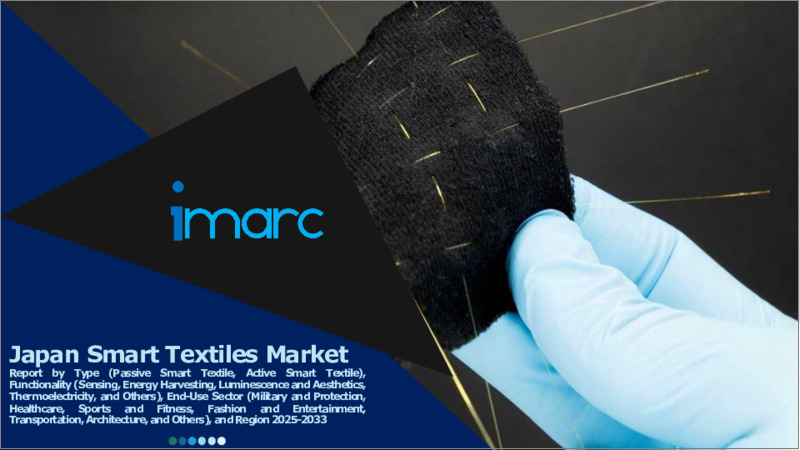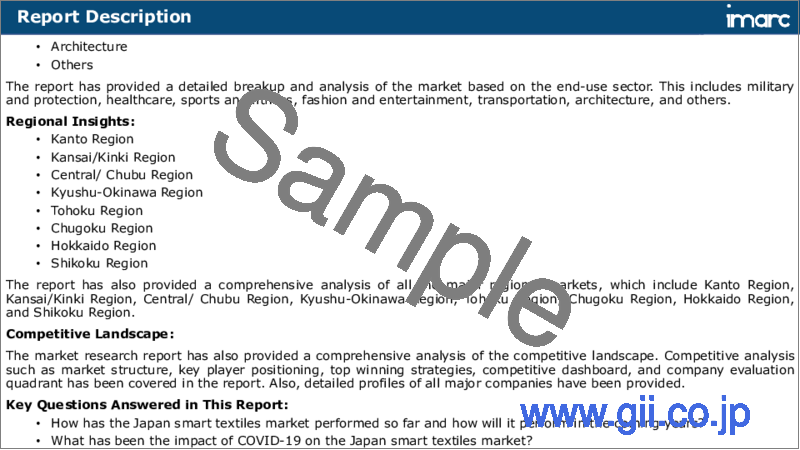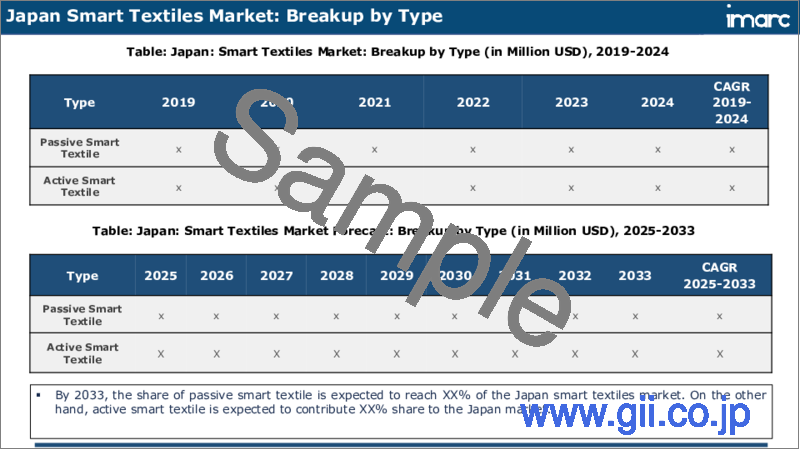|
|
市場調査レポート
商品コード
1746687
日本のスマートテキスタイル市場レポート:タイプ別、機能別、最終用途分野別、地域別、2025年~2033年Japan Smart Textiles Market Report by Type, Functionality, End-Use Sector, and Region 2025-2033 |
||||||
カスタマイズ可能
|
|||||||
| 日本のスマートテキスタイル市場レポート:タイプ別、機能別、最終用途分野別、地域別、2025年~2033年 |
|
出版日: 2025年06月02日
発行: IMARC
ページ情報: 英文 119 Pages
納期: 5~7営業日
|
全表示
- 概要
- 目次
日本のスマートテキスタイル市場規模は2024年に2億5,090万米ドルに達しました。今後、IMARC Groupは、同市場が2033年までに15億4,700万米ドルに達し、2025年から2033年にかけて20.5%の成長率(CAGR)を示すと予測しています。継続的な健康指標のモニタリングに対する需要の増加、モノのインターネット(IoT)の急速な拡大、助成金や税制優遇措置による支援の高まりが、市場の成長を促進する主な要因です。
本レポートで扱う主な質問
- 日本のスマートテキスタイル市場はこれまでどのように推移し、今後どのように推移するのか?
- COVID-19が日本のスマートテキスタイル市場に与えた影響は?
- 日本のスマートテキスタイル市場のタイプ別区分は?
- 日本のスマートテキスタイル市場の機能別区分は?
- 日本のスマートテキスタイル市場の用途別区分は?
- 日本のスマートテキスタイル市場のバリューチェーンにおける各ステージとは?
- 日本のスマートテキスタイル市場の主な促進要因と課題は何か?
- 日本のスマートテキスタイル市場の構造と主要プレーヤーは?
- 日本のスマートテキスタイル市場における競合の程度は?
目次
第1章 序文
第2章 調査範囲と調査手法
- 調査の目的
- ステークホルダー
- データソース
- 市場推定
- 調査手法
第3章 エグゼクティブサマリー
第4章 日本のスマートテキスタイル市場- イントロダクション
- 概要
- 市場力学
- 業界動向
- 競合情報
第5章 日本のスマートテキスタイル市場情勢
- 過去および現在の市場動向(2019~2024年)
- 市場予測(2025~2033年)
第6章 日本のスマートテキスタイル市場- タイプ別内訳
- パッシブスマートテキスタイル
- アクティブスマートテキスタイル
第7章 日本のスマートテキスタイル市場- 機能別内訳
- センシング
- エネルギーハーベスティング
- 発光と美学
- 熱電気
- その他
第8章 日本のスマートテキスタイル市場- 最終用途分野別内訳
- 軍事と防衛
- ヘルスケア
- スポーツとフィットネス
- ファッションとエンターテイメント
- 輸送機関
- 建築
- その他
第9章 日本のスマートテキスタイル市場- 競合情勢
- 概要
- 市場構造
- 市場企業のポジショニング
- 主要成功戦略
- 競合ダッシュボード
- 企業評価象限
第10章 主要企業のプロファイル
第11章 日本のスマートテキスタイル市場- 業界分析
- 促進要因・抑制要因・機会
- ポーターのファイブフォース分析
- バリューチェーン分析
第12章 付録
Japan smart textiles market size reached USD 250.9 Million in 2024. Looking forward, IMARC Group expects the market to reach USD 1,547.0 Million by 2033, exhibiting a growth rate (CAGR) of 20.5% during 2025-2033. The increasing demand for continuous health metric monitoring, the swift expansion of the Internet of Things (IoT), and the rising backing through grants and tax incentives are primary drivers fostering the market's growth.
Smart textiles, also referred to as e-textiles, are fabrics that incorporate digital components such as sensors, microcontrollers, and conductive fibers. These textiles possess the capability to detect, respond to, and adapt to environmental conditions or stimuli originating from mechanical, thermal, or chemical sources. Unlike conventional fabrics, smart textiles offer interactive features and have the capacity to transmit data. They are finding increasing applications in various sectors, including healthcare, sports, military, and fashion. In the healthcare field, they can monitor vital signs and send alerts to medical professionals. In sports, they can record performance metrics. Military applications involve advanced camouflage and body armor equipped with integrated communication systems.
Japan Smart Textiles Market Trends:
The rising demand for smart textiles in the healthcare sector is a primary driver of market growth in Japan. With an aging population and an increase in chronic illnesses, there is a growing requirement for continuous monitoring of health parameters like heart rate, temperature, and blood pressure. Smart textiles provide a discreet and convenient solution to meet this need. Furthermore, the rapid expansion of the Internet of Things (IoT) is making a significant contribution to the growth of the smart textiles market. As IoT devices become more prevalent, there is a heightened demand for seamless integration between hardware and user experience. Additionally, consumer electronics and wearables have become integral parts of daily life, making the integration of smart textiles a natural progression. Governments and regulatory bodies are also recognizing the potential of smart textiles across various sectors, including healthcare, defense, and public safety. This recognition has led to increased support in the form of grants, tax incentives, and research funding for companies operating in the smart textiles industry. This regulatory backing has the potential to expedite research and development efforts, facilitate the growth of small startups, and encourage collaborations between textile manufacturers and technology firms, which in turn, will catalyze the regional market in the coming years.
Japan Smart Textiles Market Segmentation:
Type Insights:
- Passive Smart Textile
- Active Smart Textile
Functionality Insights:
- Sensing
- Energy Harvesting
- Luminescence and Aesthetics
- Thermoelectricity
- Others
End-Use Sector Insights:
- Military and Protection
- Healthcare
- Sports and Fitness
- Fashion and Entertainment
- Transportation
- Architecture
- Others
Competitive Landscape:
The market research report has also provided a comprehensive analysis of the competitive landscape. Competitive analysis such as market structure, key player positioning, top winning strategies, competitive dashboard, and company evaluation quadrant has been covered in the report. Also, detailed profiles of all major companies have been provided.
Key Questions Answered in This Report:
- How has the Japan smart textiles market performed so far and how will it perform in the coming years?
- What has been the impact of COVID-19 on the Japan smart textiles market?
- What is the breakup of the Japan smart textiles market on the basis of type?
- What is the breakup of the Japan smart textiles market on the basis of functionality?
- What is the breakup of the Japan smart textiles market on the basis of end-use sector?
- What are the various stages in the value chain of the Japan smart textiles market?
- What are the key driving factors and challenges in the Japan smart textiles?
- What is the structure of the Japan smart textiles market and who are the key players?
- What is the degree of competition in the Japan smart textiles market?
Table of Contents
1 Preface
2 Scope and Methodology
- 2.1 Objectives of the Study
- 2.2 Stakeholders
- 2.3 Data Sources
- 2.3.1 Primary Sources
- 2.3.2 Secondary Sources
- 2.4 Market Estimation
- 2.4.1 Bottom-Up Approach
- 2.4.2 Top-Down Approach
- 2.5 Forecasting Methodology
3 Executive Summary
4 Japan Smart Textiles Market - Introduction
- 4.1 Overview
- 4.2 Market Dynamics
- 4.3 Industry Trends
- 4.4 Competitive Intelligence
5 Japan Smart Textiles Market Landscape
- 5.1 Historical and Current Market Trends (2019-2024)
- 5.2 Market Forecast (2025-2033)
6 Japan Smart Textiles Market - Breakup by Type
- 6.1 Passive Smart Textile
- 6.1.1 Overview
- 6.1.2 Historical and Current Market Trends (2019-2024)
- 6.1.3 Market Forecast (2025-2033)
- 6.2 Active Smart Textile
- 6.2.1 Overview
- 6.2.2 Historical and Current Market Trends (2019-2024)
- 6.2.3 Market Forecast (2025-2033)
7 Japan Smart Textiles Market - Breakup by Functionality
- 7.1 Sensing
- 7.1.1 Overview
- 7.1.2 Historical and Current Market Trends (2019-2024)
- 7.1.3 Market Forecast (2025-2033)
- 7.2 Energy Harvesting
- 7.2.1 Overview
- 7.2.2 Historical and Current Market Trends (2019-2024)
- 7.2.3 Market Forecast (2025-2033)
- 7.3 Luminescence and Aesthetics
- 7.3.1 Overview
- 7.3.2 Historical and Current Market Trends (2019-2024)
- 7.3.3 Market Forecast (2025-2033)
- 7.4 Thermoelectricity
- 7.4.1 Overview
- 7.4.2 Historical and Current Market Trends (2019-2024)
- 7.4.3 Market Forecast (2025-2033)
- 7.5 Others
- 7.5.1 Historical and Current Market Trends (2019-2024)
- 7.5.2 Market Forecast (2025-2033)
8 Japan Smart Textiles Market - Breakup by End-Use Sector
- 8.1 Military and Protection
- 8.1.1 Overview
- 8.1.2 Historical and Current Market Trends (2019-2024)
- 8.1.3 Market Forecast (2025-2033)
- 8.2 Healthcare
- 8.2.1 Overview
- 8.2.2 Historical and Current Market Trends (2019-2024)
- 8.2.3 Market Forecast (2025-2033)
- 8.3 Sports and Fitness
- 8.3.1 Overview
- 8.3.2 Historical and Current Market Trends (2019-2024)
- 8.3.3 Market Forecast (2025-2033)
- 8.4 Fashion and Entertainment
- 8.4.1 Overview
- 8.4.2 Historical and Current Market Trends (2019-2024)
- 8.4.3 Market Forecast (2025-2033)
- 8.5 Transportation
- 8.5.1 Overview
- 8.5.2 Historical and Current Market Trends (2019-2024)
- 8.5.3 Market Forecast (2025-2033)
- 8.6 Architecture
- 8.6.1 Overview
- 8.6.2 Historical and Current Market Trends (2019-2024)
- 8.6.3 Market Forecast (2025-2033)
- 8.7 Others
- 8.7.1 Historical and Current Market Trends (2019-2024)
- 8.7.2 Market Forecast (2025-2033)
9 Japan Smart Textiles Market - Competitive Landscape
- 9.1 Overview
- 9.2 Market Structure
- 9.3 Market Player Positioning
- 9.4 Top Winning Strategies
- 9.5 Competitive Dashboard
- 9.6 Company Evaluation Quadrant
10 Profiles of Key Players
- 10.1 Company A
- 10.1.1 Business Overview
- 10.1.2 Product Portfolio
- 10.1.3 Business Strategies
- 10.1.4 SWOT Analysis
- 10.1.5 Major News and Events
- 10.2 Company B
- 10.2.1 Business Overview
- 10.2.2 Product Portfolio
- 10.2.3 Business Strategies
- 10.2.4 SWOT Analysis
- 10.2.5 Major News and Events
- 10.3 Company C
- 10.3.1 Business Overview
- 10.3.2 Product Portfolio
- 10.3.3 Business Strategies
- 10.3.4 SWOT Analysis
- 10.3.5 Major News and Events
- 10.4 Company D
- 10.4.1 Business Overview
- 10.4.2 Product Portfolio
- 10.4.3 Business Strategies
- 10.4.4 SWOT Analysis
- 10.4.5 Major News and Events
- 10.5 Company E
- 10.5.1 Business Overview
- 10.5.2 Product Portfolio
- 10.5.3 Business Strategies
- 10.5.4 SWOT Analysis
- 10.5.5 Major News and Events
11 Japan Smart Textiles Market - Industry Analysis
- 11.1 Drivers, Restraints, and Opportunities
- 11.1.1 Overview
- 11.1.2 Drivers
- 11.1.3 Restraints
- 11.1.4 Opportunities
- 11.2 Porters Five Forces Analysis
- 11.2.1 Overview
- 11.2.2 Bargaining Power of Buyers
- 11.2.3 Bargaining Power of Suppliers
- 11.2.4 Degree of Competition
- 11.2.5 Threat of New Entrants
- 11.2.6 Threat of Substitutes
- 11.3 Value Chain Analysis






